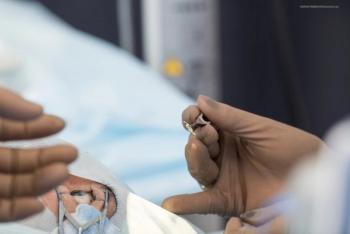
When it comes to recommending a premium IOL, a patient’s glaucoma is only one factor to consider. Just like any other patient planning cataract surgery, visual needs and preferences for/against glasses are also important factors.

When it comes to recommending a premium IOL, a patient’s glaucoma is only one factor to consider. Just like any other patient planning cataract surgery, visual needs and preferences for/against glasses are also important factors.

Residual astigmatism is not uncommon after toric IOL implantation. Depending on its cause and magnitude, lens reorientation may be a good solution.

A 4-year study following trifocal IOL implantation (AT LISA tri 839MP, Carl Zeiss Meditec) found that the lens provided good distance, near, and intermediate visual acuity. The lens also improved patient quality of vision with better diffraction and less reduction in contrast sensitivity.

Cataract and refractive surgeons should use prophylaxis to avoid reactivation of the herpes simplex virus (HSV) in patients with a history of infection with this virus, according to Elizabeth Yeu, MD.

Implantation of an investigational device for presbyopia resulted in a minimal 2-line increase in distance-corrected near visual acuity and an actual reduction in the amount of near add needed over time, show findings from a single-center, subgroup analysis.

A comparative analysis suggests placement of a cornea inlay (Kamra, AcuFocus) has improved patient satisfaction, refractive stability, and visual results when placed at 250 μm or deeper in the cornea. Shallower implantation depths may be more prone to refractive instability and lower patient satisfaction.

The use of epi-on photorefractive intrastromal cross linking reduced myopia by about 0.25 D in a small study; In a high-oxygen group, the effect averaged 1.25 D.

Hyperopic SMILE is being investigated in a prospective study. Early outcomes show good efficacy, safety, and predictability along with some interesting differences compared with hyperopic LASIK.

Wavefront-guided LASIK and wavefront-guided PRK following previous keratorefractive surgery demonstrate similar safety, efficacy, and predictability and result in comparable wavefront outcomes.

Excimer laser treatments using vector planning resulted in less corneal astigmatism, less refractive cylinder, and better unaided visual acuity postoperatively than treatments using manifest refractive treatment parameters alone, according to Noel Alpins, MD.

A new questionnaire can help assess candidates’ symptoms before LASIK surgery, monitor them for visual symptoms as well as satisfaction after LASIK surgery, and measure the impact any post-LASIK symptoms have on a patient’s ability to function.

Decentration of less than 0.75 mm from a light-constricted pupil with a novel corneal inlay for the surgical correction of presbyopia does not affect visual acuity, task performance, or severity of halos and glare.

Patients with a contact lens lost in the eye are not a rare occurrence for ophthalmologists. However, 27 lenses at the same time may be another story! Another ophthalmologist shares his experience with a case involving 5 lenses within a patient's eye.

Presbyopia patients have changed. They are younger than ever, more active than ever before, and they have more treatment options than ever before.

Sometimes, we ophthalmologists-accustomed as we are to high-success rates with our therapeutic interventions-become inured to the impact our efforts can have on patients’ lives.

Advancements in wavefront-guided technology include improved resolution that provides not only better spot quality but also the ability to scan highly aberrated eyes that often did not produce treatable images using earlier technology, according to Edward E. Manche, MD.

Advances in presbyopia, dry eye and allergy, and age-related macular degeneration filled this year’s meeting of the Association for Research in Vision and Ophthalmology.

A preliminary analysis of a dataset containing more than 300,000 eyes treated with LASIK between 6 to 10 years ago is beginning to quantify some of the risks for ectasia.

When considering premium surgeries and high expectations from patients along with an unrelenting quest for vision exceeding 20/20, the tolerance of residual astigmatism must be zero. Like bespoke tailors, ophthalmologists need to be bespoke surgeons who tailor vision in each eye to the highest level possible. We cannot claim to design the best suit using the best technology and tailoring materials, and yet, in our minds, find it “acceptable” to have the suit length within a half-inch to three-quarters of an inch too short or wide.

A review of 800 cases of small incision lenticule extraction for treatment of myopia and myopic astigmatism shows an evolution in surgical indications and technique with consistently positive outcomes.

The UK Federation of (Ophthalmic and Dispensing) Opticians (FODO) is calling for a mediation service to handle disputes over refractive surgery.

The 2017 meeting of the American Society of Cataract and Refractive Surgery (ASCRS) will be held May 5 to 9 at the Los Angeles Convention Center, but at least one guest speaker will be sharing his “out-of-this-world” experiences.

A third system upgrade for a femtosecond laser system for refractive cataract surgery (Streamline III, LENSAR) will enhance the efficiency of the procedure, according to Jonathan Solomon, MD.

All of these cases scenarios, which are an everyday occurrence in my practice, demonstrate my desire to take every patient to emmetropia despite the “so-called” complexity of the cases.

Poor regeneration of the epithelial basement accounts for most 'late haze' associated with PRK, LASIK, infections, or corneal transplants. Proper excimer laser maintenance may reduce irregularities.